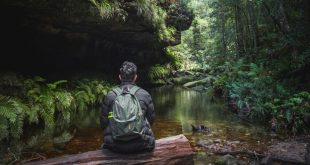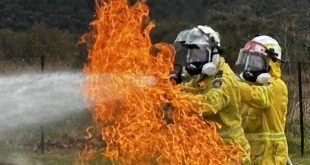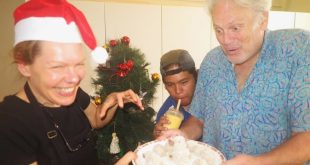Will talks about the endangered Dwarf Mountain Pine, a true living fossil, in this video by Kalani Gacon.
Thanks to generous funding from the NSW Saving Our Species program, Council is undertaking extensive catchment protection works to safeguard the Dwarf Mountain Pine.
Story by Linda Moon
A cadetship with the Healthy Waterways Team at Blue Mountains City Council has helped 23-year-old Will Goodwin pursue a passion for helping wildlife and nature.
Key Points:
- Many children dream of working with wildlife. Will Goodwin went on to make his dream a reality.
- Citizen science and volunteering is another way to get involved.
- Will says hope, working together, and focusing on your circle of influence is the key to making a difference.
Growing up in Faulconbridge, 23-year-old Will Goodwin spent a lot of his childhood in the bush. Two incidents in particular had an impact on him. At age eight, he had his first glimpse of a Giant Spiny Crayfish down at Hazelbrook Creek. The moment was one of awe. “At the time I didn’t know they were endangered,” he recalled. Tragically, in 2023 the population was decimated by contamination of the waterway with the pesticide Bifenthrin.
After his HSC, Will’s mother took him on a life-changing road trip to the Outback. In Menindee they heard news of a major fish death event affecting the Darling River. “That’s when I realised how important water is,” Will said.
Will also observed how much lushness and life existed around the Darling River compared to the rest of the arid landscape. The approach to the river was green, brimming with wildlife and towering River Red Gums. It was water that made the difference. “It’s something we don’t value as much as we should,” he reflected. “We should really look after that.”
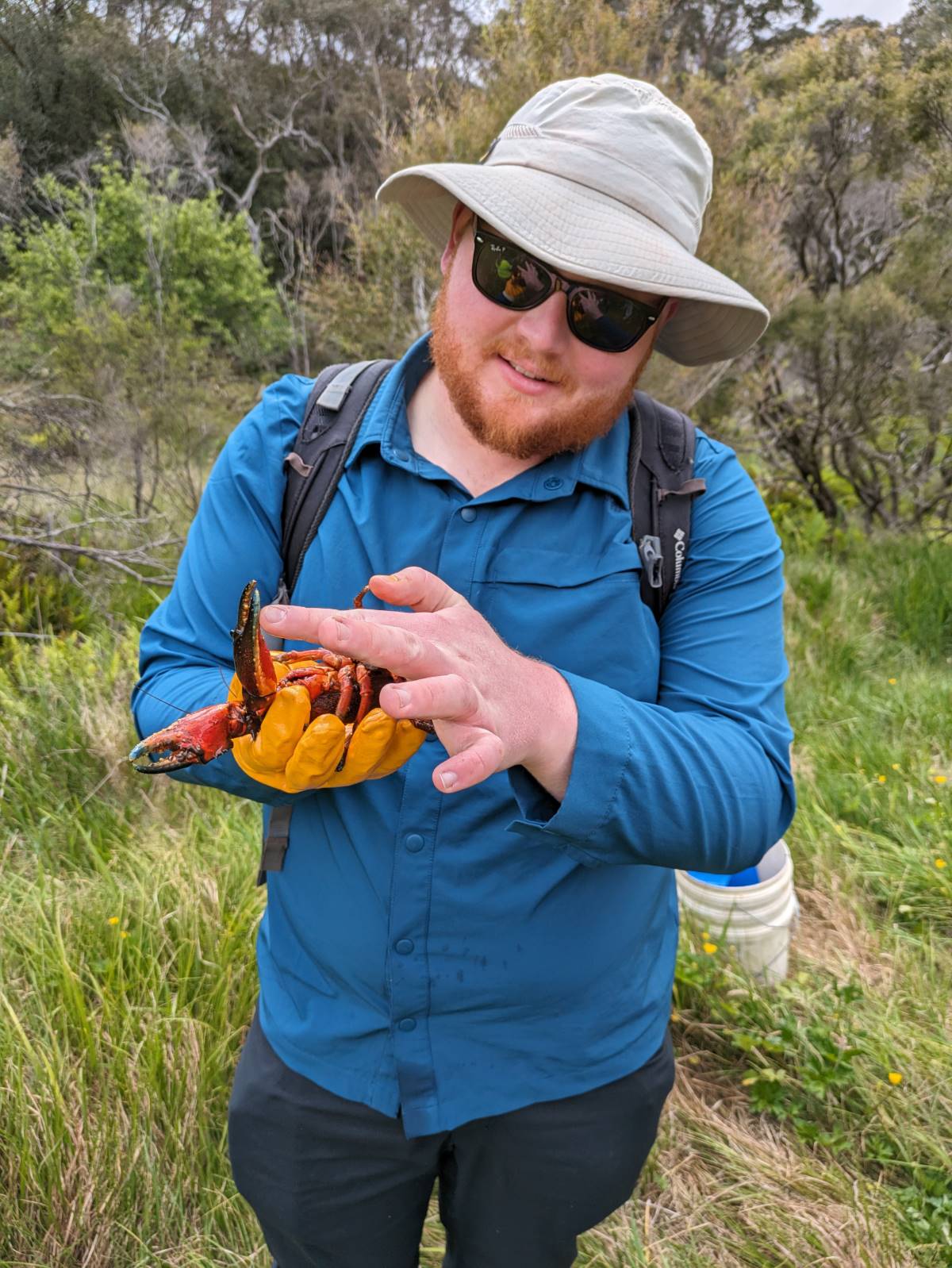
Will with a Giant Spiny Crayfish. “It’s been great to look after the crayfish and waterways. These are incredibly ancient animals that can live for a hundred years.” (Photo: Amy St Lawrence)
BMCC Healthy Waterways cadet
Fast forward to now and the Katoomba resident is directly involved in helping protect water quality as a cadet with the Healthy Waterways Team at Blue Mountains City Council (BMCC). In what seems serendipity, Will is one of the first environmental science cadets for the Team. Concurrently, he’s completing a Bachelor of Natural Sciences at Western Sydney University.
“I think the biggest highlight of my job has been the people I’ve had the privilege of working with. Every day I work alongside such smart, compassionate people, who have dedicated their lives to caring for something bigger themselves. They have been such generous teachers, and I have learned so much from them. “
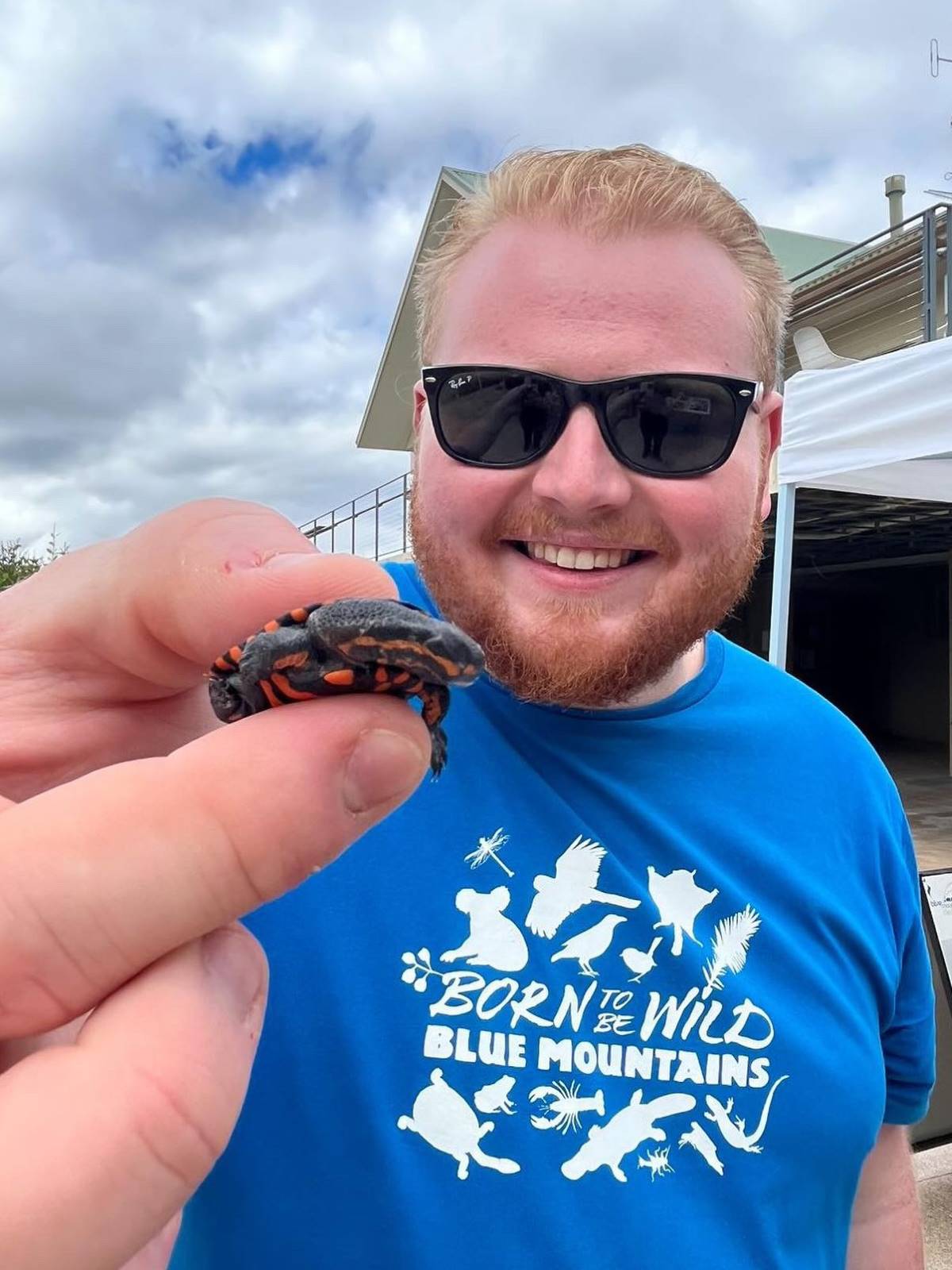
Will Goodwin holding a newly hatched Eastern Long-Necked Turtle. “One of my pet projects in the last couple of years is turtles.” (Photo: Holly Nettle)
“What I also love is that no day is typical,” he enthused. Each year, the team visits and assesses 70 sites across the Blue Mountains to monitor human impact on local waterways. This includes remote areas where no human goes. “Which mostly means working in nice places,” Will said. “There’s only two cities on the planet in a World Heritage area – Banff (in Canada) and us. So that’s a pretty unique position to be in.”
It also presents challenges for the environment.
Our vulnerable waterways
“We are sitting right on top of a hill and we use all the waterways as our drains,” he lamented. “So, all the leaky cars and leaky sewers are going into the stormwater system – their sole purpose is out of sight, out of mind. In most cases there’s absolutely no filtration. So all the problems in our own backyards are getting an express ticket into the wilderness.”
A lot of our villages are old and have terracotta pipes that are easily cracked, Will further explained. Roots only infiltrate pipes that are leaking in the first place: “they’re not omniscient,” he said.
Monitoring water issues
The team test for parameters like water temperature, turbidity (cloudiness), pH and faecal bacteria. Nitrogen and phosphorus – also tested – are the main ingredients in fertilisers and organics like sewerage. “When there’s too much of that you get algal bloom and weeds growing,” he said.
But, because of cost factors, not all toxins can be monitored. The team are unable, for example, to routinely test for heavy metals or forever chemicals like PFOS.
The best gauge of ongoing water health is counting bugs. Some aquatic bugs (such as the larval stages of Mayflies, Stoneflies, Caddisflies and Dragonflies) are sensitive to pollution. “And the lab tests only tell us what the water is doing at that time,” Will said.
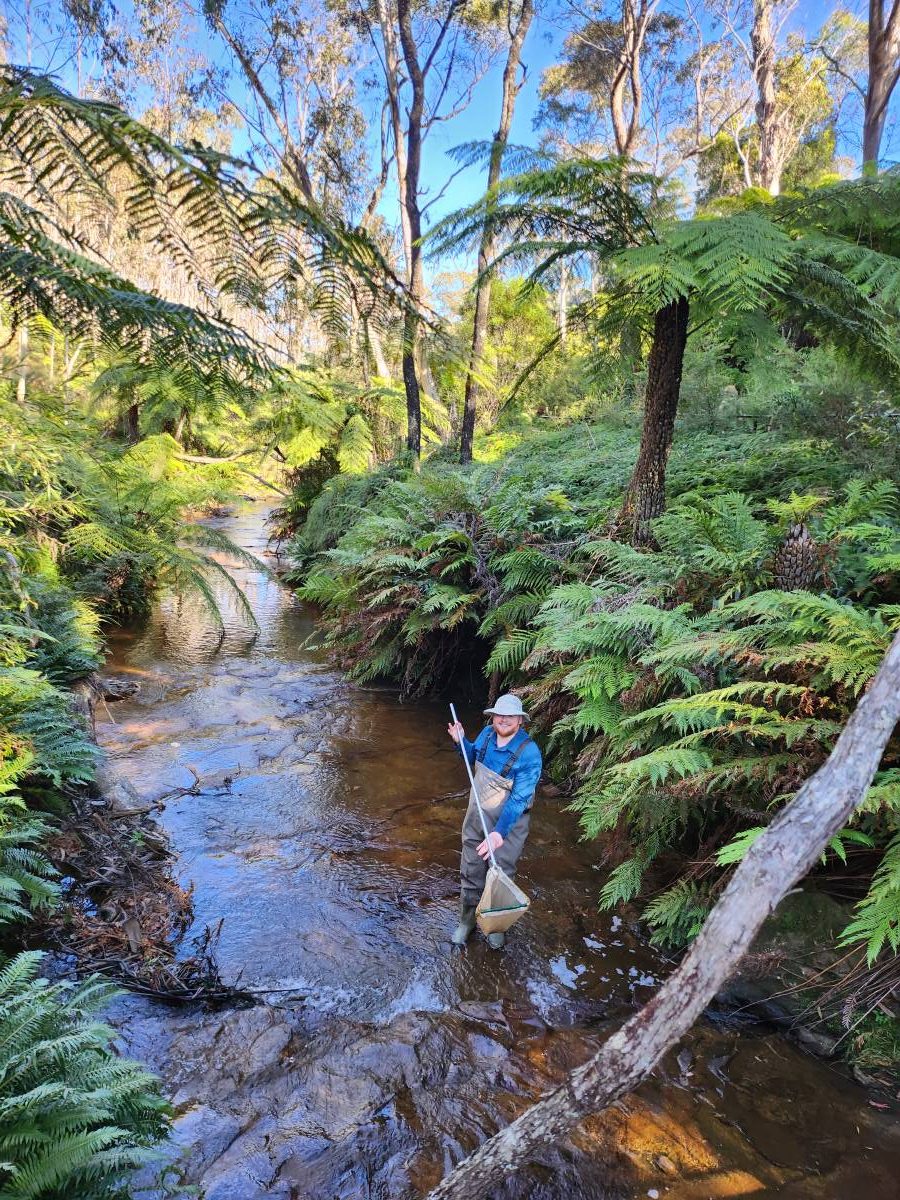
On the job at Leura Cascades. “I’m privileged to live in such an incredible place.” Photo: Amy St Lawrence
Fixing environmental problems
As part of his cadetship, another “pet project” of Will’s – the Blue Mountains Perch – is also threatened by water issues. “Out of all the vertebrates in the mountains, I think it’s the most likely to go extinct,” he said. “Again, it’s storm water doing it – driveways and construction sites, soil going into creeks, blanketing over the breeding habitat.”
“Stormwater is our most pressing environmental issue in the Mountains. It’s so destructive, but also something we can fix.”
He offers the powerful example of the restoration of Minnehaha Falls. In the early 2000s it was inundated with sand. Improvements to storm water – some filtration, rain gardens and pollutant traps, helped clean up the water. “Then it just rained and rained and the water just flushed out the sand itself,” Will said.
“Nature has an incredible ability to heal if we fix what’s hurting it in the first place.” – Will Goodwin.
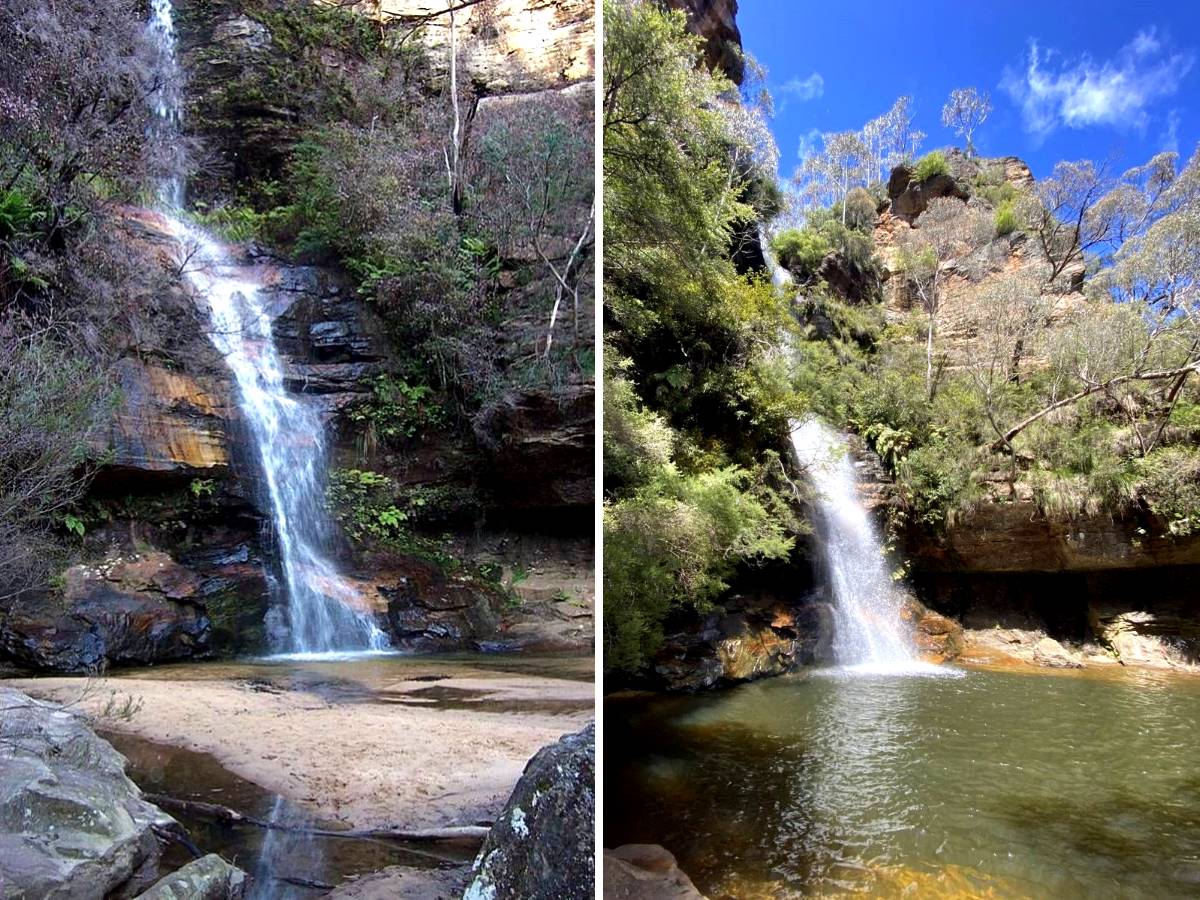
Minnehaha Falls at Katoomba in 2003 (left) and 2022 (right).
Education is key
Another big aspect of the job is education. “So that is getting kids out in bush connecting with nature,” he said. He’s worked with all ages from babies to seniors. “All of those age ranges love holding a turtle. You don’t need to teach kids to love nature. They innately do.”
“Fundamentally, the most important thing is encouraging people to care and facilitate change.”
Citizen science to the rescue
Long before he started University, Will was a passionate advocate for wildlife. He’s contributed to iNaturalist, FrogID, the Aussie Bird Count and more.
To prove the value of citizen science, he tells the story of a woman in his street who photographed a strange bee. It turned out to be Sericogaster fasciata, a bee previously thought to be extinct.
A recent study found a whopping half of all species recorded in the Atlas of Living Australia come from citizen scientists.
Will’s recent nature discoveries include finding scorpions and bioluminescent fungi on one of his favourite bush trails at night – with the aid of a UV torch light. “The more you look the more you realise that you’re just scratching the surface,” he said.
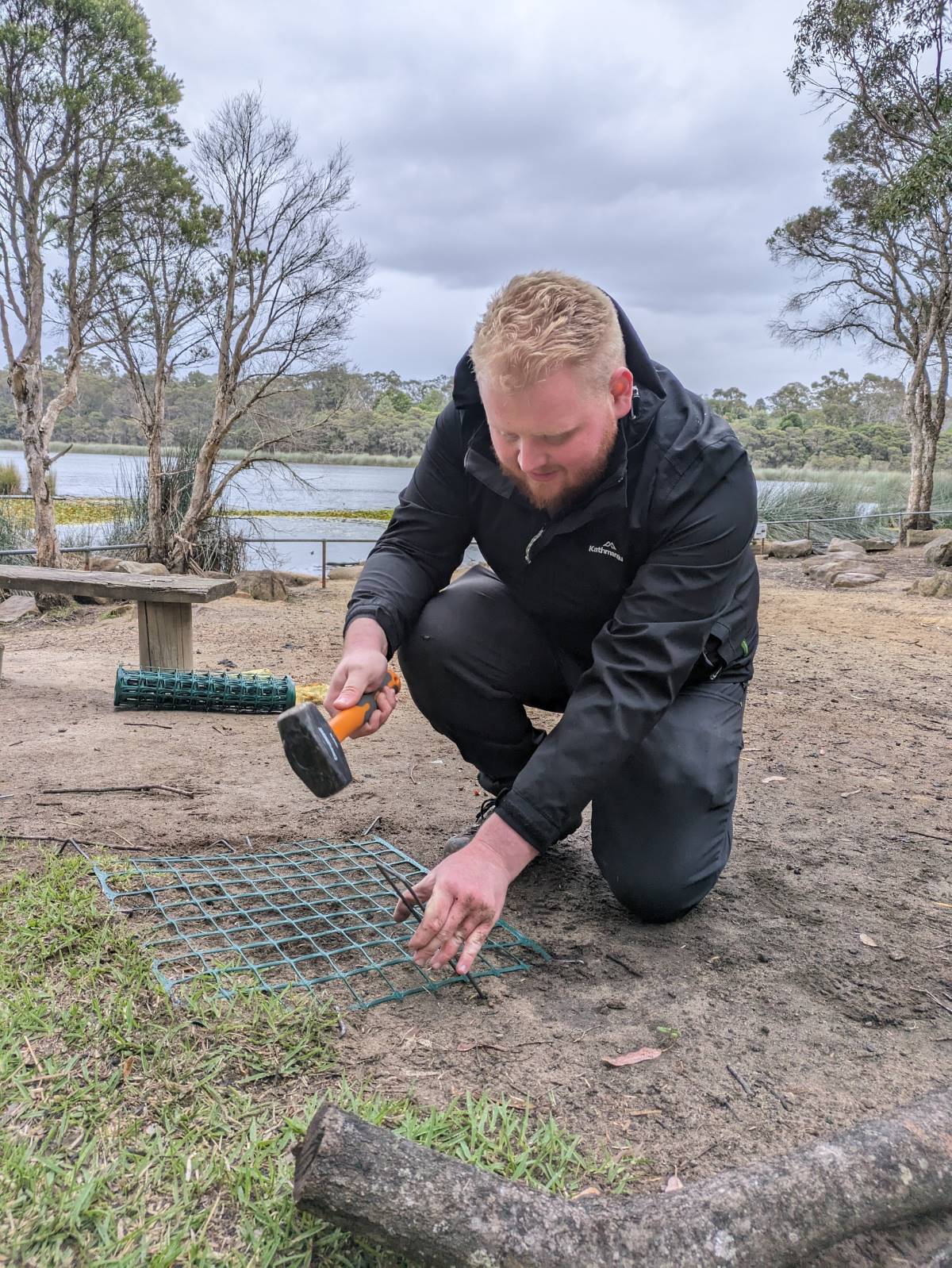
Will Goodwin protecting a turtle nest at Glenbrook Lagoon, says, “Science can be fun.” Photo: Amy St Lawrence
Going social
Will also posts environmental videos to his Tik Tok channel. After his video on how to recycle the foil of Easter eggs went viral he became interested in science communications.
“As one person you can only do so much. If you can bring others along with you on the journey, that’s how we will get where we need to go.”
“It’s easy to think you can’t make a difference. A lack of hope stymies progress.” – Will Goodwin.
Careers in environmental science
Will encourages others to work in the environment and said it’s a growing field. “We need more people.”
While environmental jobs in areas like mining and development can conflict with values, “the reality is we need people who care in all of those roles,” he said.
How to make a difference
But you don’t have to work in the field to help wildlife. The passionate nature lover is brimming with stories that prove how just one person in their local area can make a difference.
One of the recent projects he’s been involved with through working at Council has been protecting turtle nests at Glenbrook Lagoon. “They’ve now hatched,” he said. “If they hadn’t been protected there’s a 95 per cent chance they’d have been eaten by foxes. Knowing there are little turtles out there because of me, it’s incredibly rewarding.”
Will also constructed basking platforms for the turtles – to give them a place to dry out safe from dogs and people. “We’ve had landholders, community groups, schools and traditional owners all noticing. Those three platforms have turned into about 25 now,” he said. “It’s snowballed and growing and that’s where I feel I can make a difference. People care and by being able to encourage and facilitate that, that’s where we’ll get where we need to go.”
“Try not to focus on what’s outside your circle of control. “Always focus on what you can do because there’s plenty you can do.” – Will Goodwin.
Take Action:
- Be part of citizen science in your local area. You could try iNaturalist, FrogID, and the Aussie Bird Count
- Learn about careers in environmental science.
- Join forces with others through volunteer groups.
Share this article:
This story has been produced as part of a Bioregional Collaboration for Planetary Health and is supported by the Disaster Risk Reduction Fund (DRRF). The DRRF is jointly funded by the Australian and New South Wales governments.
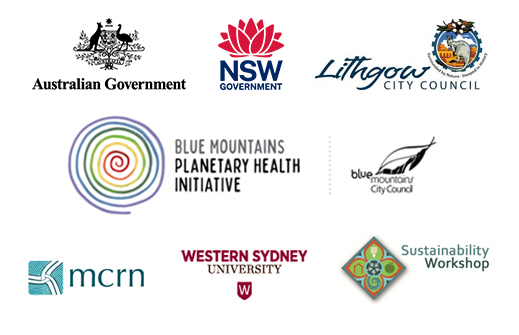
More from around the region
It was gloriously sunny and we had a fabulous day of sharing at the Planetary Health Centre yesterday, from T`ai-chi to workshops on the Frogs of the Blue Mountains, Fashion Upcycling and How to Build a Survival Garden in the Blue Mountains. We finished with a Bushcare session in which we enjoyed the beautiful bushland on the site and removed invasive weeds to expand the habitat for wildlife around our swamp. We were joined by frogs in our pond and the little echidna who returned for a swim! Thank you to everyone who shared so generously. We tasted Yacon and shared rhizomes, Purple Congo Potatoes, Oca, Turmeric, and seeds for Salsify, Egyptian Spinach, Red Mustard, Echinacea, Parsley, Chard, Radish, and Red Noodle Beans. Our next Skillshare Saturday will be on the first Saturday of May. If you`d like to be notified of all our workshops, and the meetings of our Seed Saving and Gardening Groups, subscribe to receive the fortnightly Planetary Health newsletter at any of our Local News sites like www.katoombalocalnews.com (links in profile) #skillshare #planetaryhealth #taichi #qigong #frogs #bluemountains #katoomba #fashionupcycling #upcyclingfashion #survivalgardens #seedsaving #loofah #community
Our Skillshare Saturdays are on the 1st Saturday of every month and we`re looking forward to a beautiful sunny day tomorrow for our first Morning T`ai-chi & Qigong. Fashion Upcycling is booked out this month, but we still have a few places for Frogs of the Blue Mountains, Building a Survival Garden and Planetary Health Bushcare. Bookings via Eventbrite (links in profile). For more information ph. 0407 437 553
#skillshare #planetaryhealth #sunnyday #katoomba #bluemountains #taichi #qigong #frogs #seedsaving #survivalgardens #bushcare
Imagine, if just once a month, everyone gave a few hours back to nature to repair the damage we`ve done. We would so quickly restore the habitat of so many species struggling to survive and provide the habitat for many more to flourish. Once a month, for three hours, our Planetary Health Bushcare group does just that. We`re repairing the damage of human impact and being immediately rewarded by our time in nature and the great company of the other members of our Bushcare Group. We`ll be meeting again this Saturday 5 April at 1.30pm and all are welcome to join us and learn more. Contact Karen Hising at [email protected] or call the Bushcare Office on 4780 5623 if you`d like to give it a try.
For more information about the Planetary Health Centre and how you can get involved contact the Planetary Health office on 0407 437 553
#bushcare #biodiversity #wildlife #habitat #regeneration #planetaryhealth #community #allinthistogether #bushcare #katoomba #bluemountains
In our `How to Build a Survival Garden in the Blue Mountains` workshop on Saturday 5 April, we`ll be starting an Upper Mountains Seed Saving group and sharing seeds, tubers, recipes for more unusual foods, and information about the many ways we can create more food system diversity and resilience. Learn about skirret, salsify, collards, cardoons, sea kale, Good King Henry, mangel wurzel, oca, yacon and more. Places are limited so bookings essential here (link in profile) : bit.ly/4kVAUA8
#foodsystems #foodsecurity #fooddiversity #foodresilience #biodiversity #planetaryhealth #healthydiet #plantbased #katoomba #bluemountains
Was that a frog or cricket you heard? Check out our video matching the photos of the 20 frogs of the Blue Mountains Mountains with their calls so you can learn the difference. View our exhibition, learn how to use the FrogID app, and how to build a frog pond and frog hotel, at our workshop this Saturday 5 April at 9am. Bookings via via link in profile. You can view our full video on YouTube (link in profile). Subscribe for more great content. #frogs #bluemountainsfrogs #planetaryhealth #katoomba #frogcalls #exhibition #workshop
A huge thank you to the Blue Mountains Interfaith Group for organising an inspiring afternoon that brought community together and renewed our sense of connection, hope, wonder, shared purpose and commitment to care for our extraordinary planet. We had a full house with the Frogs of the Blue Mountains looking over our shoulders! Next Saturday 5 April we`ll be launching Saturday morning T`ai-chi and Qigong which will continue on the first Saturday of every month. Bookings essential here (link in profile): bit.ly/3Rn9RzY #interfaith #hope #wonder #commitment #connection #community #planetaryhealth #katoomba #bluemountains #taichi #qigong
Our Planetary Health Newsletter is out! Read it here https://bit.ly/4l7sC89 (link in profile) to find out how Planetary Health has been at the core of Blue Mountains City Council`s Sustainability Model and Map for Action for 25 years and what it means; watch our `We Are Nature` video and our latest video on the Frogs of the Blue Mountains and all their calls; read about how we`re focusing on what connects us, not what separates us, at the Interfaith Gathering this Sunday 30 March; learn how you can take action for Planetary Health on Saturday 5 April with T`ai-chi & Qigong, workshops on the Frogs of the Blue Mountains and building Survival Gardens; and participating in Planetary Health Bushcare. There`s also still time to apply for our Conference and Events Organiser position at the Planetary Health Centre. You can subscribe to receive the newsletter at any of our local news sites, like www.katoombalocalnews.com (link in profile)
@ph_alliance
#planetaryhealth #sustainability #jobs #taichi #qigong #survivalgardens #frogs #bluemountains #katoomba #mapforaction #sustainabilitymodel #wearenature #interfaith #bushcare #community #action


